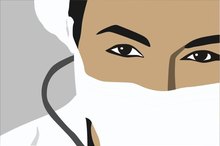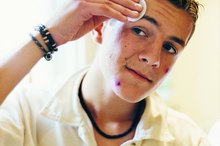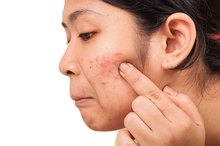Molluscum Vs. Seed Wart
Warts are viral infections of the outer layer of skin that can affect children and adults. Just like molluscum contagiosum, another common skin infection, warts are usually more of a nuisance than a real health danger. Both infections share some similarities, but remain distinct in their causes, location and appearance.
Types
Several types of warts have been defined. The term seed wart usually refers to common warts. They are so named because blood vessels in the wart resemble black dots or “seeds” or have dangling fronds like palm trees. In contrast, molluscum contagiosium comes in only one type, according to the Merck Manual 3.
- Several types of warts have been defined.
- The term seed wart usually refers to common warts.
Causes
How to Determine if a Face Blemish Is a Wart or Pimple
Learn More
A poxvirus causes molluscum contagiosum while warts result from an infection with a human papilloma virus, or HPV. Although the HPV family consists of more than 100 types, only a few of them cause seed warts, notes University College's dermatologist Johnny Bourke. Molluscum and seed warts are often associated with outbreaks in communal areas, such as swimming pools and locker room floors. You might acquire the infection as a result of minor cuts, prolonged exposure to moisture, and rubbing while exposed to the viral particles in the communal area. The infection can then spread by scratching, picking, or through towels and bath sponges.
- A poxvirus causes molluscum contagiosum while warts result from an infection with a human papilloma virus, or HPV.
- Molluscum and seed warts are often associated with outbreaks in communal areas, such as swimming pools and locker room floors.
Signs & Symptoms
Molluscum lesions typically form clusters of small, solid and pearly skin-colored bumps on the skin. Both molluscum and seed warts normally have diameters lower than 10 mm, notes Bourke. However, molluscum lesions may be much larger in patients with weak immune systems, especially those with HIV. Molluscum lesions do not usually cause pain, but you might experience mild pain with seed warts. Pus in a molluscum in contagiosum is not normal, but the lesion may be red and itchy.
- Molluscum lesions typically form clusters of small, solid and pearly skin-colored bumps on the skin.
- Pus in a molluscum in contagiosum is not normal, but the lesion may be red and itchy.
Locations & Course
Hair Growth From Warts
Learn More
Seed warts most commonly develop on the fingers, hands, palms, legs and face. Molluscum lesions may last from a few months to years, but eventually heal spontaneously, Bourke said. Likewise, seed warts often disappear on their own. However, people may seek treatment for cosmetic reasons, to prevent sexual spread, or for fear that the lesions may become sore or infected. Bourke also notes that, in rare cases, some warts can progress to cancerous forms.
- Seed warts most commonly develop on the fingers, hands, palms, legs and face.
- Likewise, seed warts often disappear on their own.
Treatment
The Merck Manual indicates that treatment options depend on the characteristics and location of the seed warts or molluscum contagiosum 23. Common destructive methods include: curettage; surgical removal, or excision; cryosurgery, which involves freezing and destroying the lesions; and laser surgery. However, because molluscum and seed warts both have viral origins, they can recur.
- The Merck Manual indicates that treatment options depend on the characteristics and location of the seed warts or molluscum contagiosum 2.
- However, because molluscum and seed warts both have viral origins, they can recur.
Related Articles
References
- "Mosby's Color Atlas and Text of Dermatology;" Johnny Bourke, M.D. and Robin Graham-Brown, M.B., F.R.C.P.; 2007
- The Merck Manual of Medical Information: Warts
- Silverberg NB. Pediatric Molluscum Contagiosum. Pediatric Drugs. 2003;5(8):505-512. doi:10.2165/00148581-200305080-00001
- Tyring SK. Molluscum contagiosum: the importance of early diagnosis and treatment. American Journal of Obstetrics and Gynecology. 2003;189(3). doi:10.1067/s0002-9378(03)00793-2
Writer Bio
Suzanne Fantar has been writing online since 2009 as an outlet for her passion for fitness, nutrition and health. She enjoys researching and writing about health, but also takes interest in family issues, poetry, music, Christ, nature and learning. She holds a bachelor's degree in biological sciences from Goucher College and a MBA in healthcare management from the University of Baltimore.








